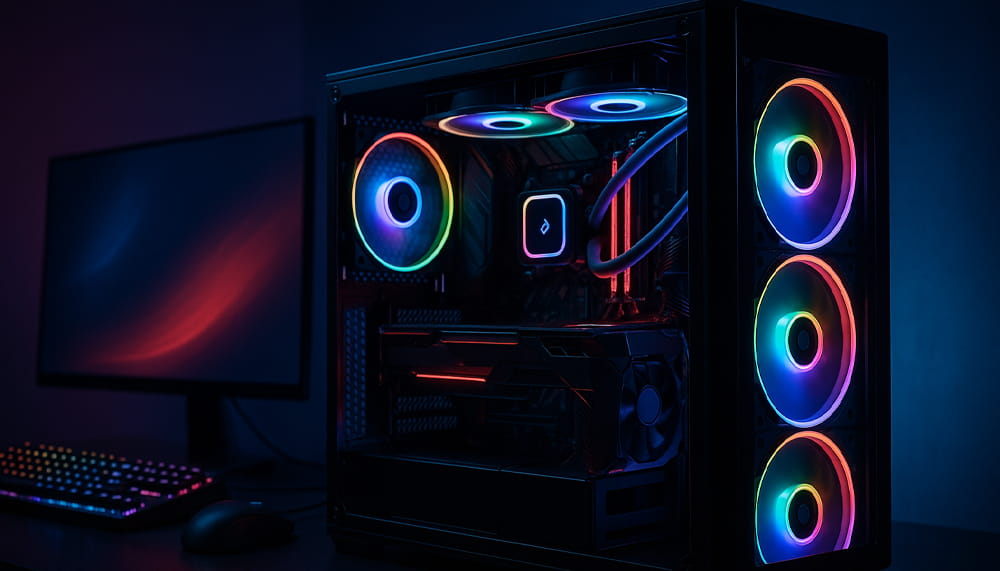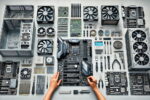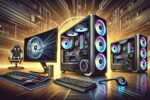Having a good gaming PC isn’t about spending the most money; it’s about carefully selecting the components, tailoring them to your budget and goals, and reviewing every part of the setup. This guide will show you:
- The essentials if you’re a beginner.
- How to improve your setup if you already have experience.
- What to do if you want to build a high-end gaming rig, with overclocking, etc.
And in each section, how Ibertrónica can help you achieve your goals.
Table of Contents
- Beginners
- Intermediate Level
- Advanced Level
- Common Elements Across All Levels
- How Ibertrónica Helps at Each Stage
- Frequently Asked Questions
- Conclusion
- Beginners
1.1 What does “entry-level gaming PC” mean?
An entry-level setup is one that allows you to play games smoothly at resolutions like 1080p, with medium-high graphics settings, without exceeding your budget.
1.2 Basic Components
| Component | Minimum/Recommended |
| CPU | A modern mid-range processor: for example, an Intel Core i5 or AMD Ryzen 5 of the latest generation. |
| GPU | A graphics card capable of running current games at 1080p. For example, RTX 4060 / RX 7700 XT, or slightly older models if you adjust the graphics settings. |
| RAM | 16 GB is now the standard, to avoid bottlenecks. |
| Storage | An NVMe SSD for the operating system and some games. 1 TB is usually the minimum comfortable capacity. |
| Power Supply (PSU) | It should have an 80 PLUS Bronze/Gold certification, and enough power for your current components, plus some headroom for future upgrades. |
| Cooling | Decent air cooling, good airflow in the case/tower. |
1.3 Step-by-step assembly
- Planning: list of components, compatibility (CPU socket, GPU size, space, connectors).
- Physical assembly: install CPU, cooler, RAM, motherboard in the case, GPU, power supply, etc.
- Cable management: organization, neat cable routing, ensuring good airflow.
- Operating system installation, drivers, BIOS settings if necessary.
1.4 Common mistakes for beginners
- Buying a power supply with barely enough power: you’ll run out of power when adding a better GPU or more fans.
- Not checking physical compatibility (GPU that doesn’t fit, small cases, power supplies that won’t fit).
- Not planning for future connections (more storage, more RAM) or expansion.
- Intermediate level
Once you have the basics, you want better performance, better graphics, stability, aesthetics, etc.
2.1 Performance Optimization
- Keep drivers up to date (GPU, chipset).
- Set the resolution and refresh rate to match your monitor.
- Adjust graphics settings in games: use DLSS, FSR, etc. if your GPU supports them.
- Avoid bottlenecks: CPU too weak for your GPU, etc.
2.2 Selecting Peripherals and Other Components
- Monitor: refresh rate (120Hz, 144Hz, 240Hz), response time, resolution (1080p, 1440p, 4K), panel type (IPS, VA, TN).
- Gaming keyboard and mouse: switches, type, comfort, latency.
- Other accessories: large mousepads, RGB lighting if aesthetics matter, quality speakers or headphones.
2.3 Customizing Your Setup
- Aesthetics: PC case design, lighting, front panel, tempered glass, visible fans.
- Organization: Cable management, stands, ventilation space, dust filters.
- Improved cooling: add fans, upgrade heat sinks, consider AIO liquid cooling if your GPU or CPU requires it.
- Advanced Level
Here we’re talking about high-end setups, 4K gaming, demanding games, streaming, overclocking, etc.
3.1 High-end hardware
- High-end CPU (Intel Core i9, AMD Ryzen 9, or equivalent), possibly with cores optimized for gaming + multitasking.
- Top-tier GPUs (RTX 4090, the highest series, or equivalent AMD models if available).
- Ample RAM: 32 GB or more, high speeds.
- Fast storage: Latest generation NVMe, multiple drives, perhaps PCIe 4.0/5.0 SSD + secondary storage.
3.2 Overclocking and stability
- GPU/CPU overclocking: requires a motherboard with good power delivery, enhanced cooling, and a good power supply.
- BIOS/UEFI: settings, profiles.
- Thermal monitoring: sensors, liquid cooling solutions, optimized airflow.
3.3 Advanced cooling
- Liquid cooling (custom loop or high-quality AIO).
- Large cases with ample space for radiators and large fans.
- Noise control: quiet fans, idle modes, PWM control.
3.4 Future testing and expansion
- Prepare the case for future GPUs.
- Reserve slots for additional SSDs.
- Power supply with headroom (e.g., 20-30% above estimated power consumption).
- Common elements across all levels
These aspects are independent of the level, but make a difference:
- Component compatibility (CPU socket, GPU size, RAM type, case space).
- Power supply quality: efficiency, certifications (80 PLUS), protections.
(See our guide on how to choose the ideal PSU)
- Adequate airflow and cooling.
- Proper driver and firmware configuration.
- Aesthetics and ergonomics of the setup: posture, lighting, workspace organization.
- How Ibertrónica can help you at every stage
Ibertrónica doesn’t just sell components; it offers specialized services and expert advice to ensure your gaming PC performs exactly as you want, without any headaches. Here’s how:
| Stage | How Ibertrónica can help |
| Beginner | Advises on selecting your first PC, choosing the right CPU, GPU, and basic components to suit your budget; provides pre-configured kits; assembly and initial testing; driver and operating system setup. |
| Intermediate | Assists with upgrades (e.g., upgrading the GPU, adding RAM, changing storage); performance optimization; installation of better cooling systems; BIOS adjustments; aesthetic enhancements (lighting, cable management). |
| Advanced | Advice on overclocking/tuning; custom liquid cooling setup; selection of high-end components; stability and redundancy solutions; specialized technical support; future system upgrades. |
In addition, Ibertrónica can offer:
- Sale of high-quality components with warranties, certifications, and reliability.
- Professional assembly, performance testing, and after-sales warranty.
- Technical support: diagnostics, troubleshooting, and maintenance.
- Turnkey packages: if you don’t want to assemble it yourself, let Ibertrónica do it and have it ready to play.
- Frequently Asked Questions (FAQ)
How much does a decent gaming PC cost? It depends largely on the level: a good entry-level system can be within a modest price range (for example, between €700 and €1000, depending on the country), while top-of-the-range systems can cost several times that amount.
Do I need 32GB of RAM?
Not always. For current games, 16GB is usually enough, but if you do heavy multitasking, streaming, editing, etc., 32GB gives you more headroom.
What power supply certification is suitable?
Ideally, 80 PLUS Gold or higher, for efficiency and reliability. Also, look for protections like OVP, UVP, and OCP, and the power supply’s form factor.
Is overclocking worth it?
It can provide extra performance, but it introduces more complexity: heat, the need for better cooling, and increased wear and tear. If you do overclock, do it with good equipment and under supervision.
- Conclusion
The key to a good gaming PC is balance: choosing the right components for your intended use, your budget, and anticipating future upgrades. It’s not just about having the most powerful components, but about ensuring that each part works well together.
With Ibertrónica, you have a partner who can support you from your first PC build to creating a top-of-the-line system, guaranteeing quality, performance, and good support. If you’d like, we can prepare some specific configuration examples for Spain in 2025, with real prices, for beginners, intermediate, and advanced users. Interested?
Discover all our configurations at the following link.







